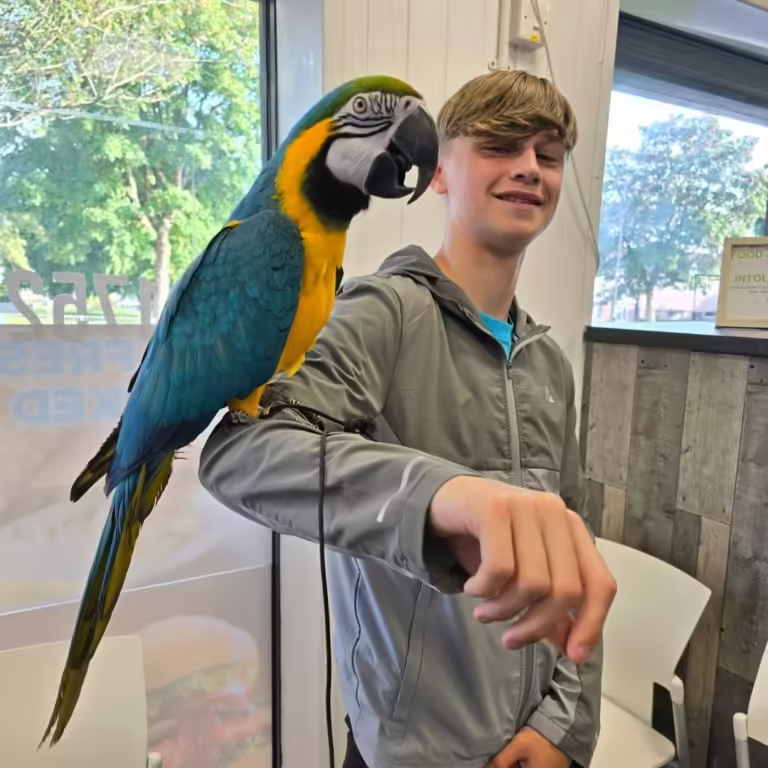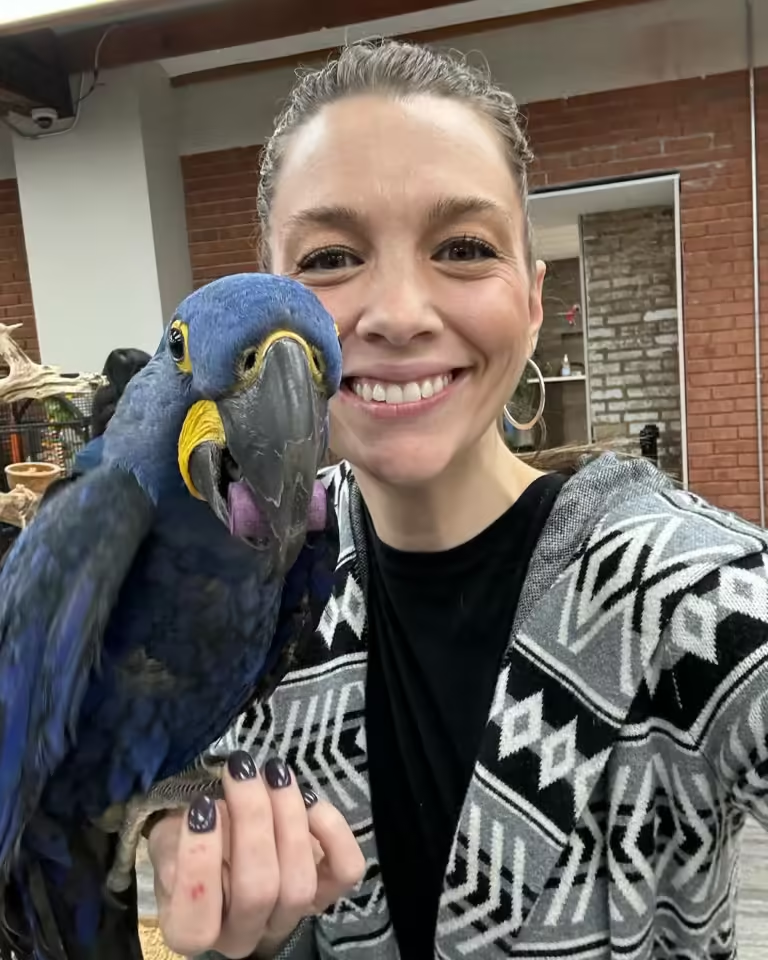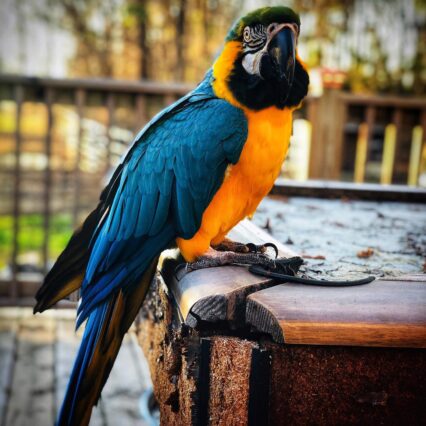- May 26, 2024
Lutino Quaker Parrot for Sale: 10 Tips for the Perfect Choice

Looking to bring home a beautiful and vibrant lutino quaker parrot? How about providing it with a variety of fruit and food? We’ve got you covered with this article that will guide you through the process of finding your perfect feathery friend. Whether you’re a seasoned bird owner or new to the world of pet birds, these tips will help you navigate the search for a lutino quaker parrot with ease.
In this listicle, we’ll explore various avenues to find a lutino quaker parrot for sale. From reputable breeders and avian specialty stores to online platforms and local bird clubs, we’ve compiled a comprehensive list of resources to assist you in your quest. So, if you’re ready to embark on this exciting journey, buckle up and scroll down for reviews of our top picks!
Browse our shop for beautiful birds. Find your perfect parrot companion today
-
Sale Product on sale
 My Name is MANGO, Male Conure. 20% Off Today – Don’t Miss Out!
My Name is MANGO, Male Conure. 20% Off Today – Don’t Miss Out!$900.00Original price was: $900.00.$700.00Current price is: $700.00. -
Sale Product on sale
 Buy JOHNNY, Male Blue Throated Macaw. 20% Off Today – Don’t Miss Out! Limited Time:
Buy JOHNNY, Male Blue Throated Macaw. 20% Off Today – Don’t Miss Out! Limited Time:$1,600.00Original price was: $1,600.00.$1,280.00Current price is: $1,280.00.
Key Takeaways
- Consider the bird’s age when looking for a lutino Quaker parrot for sale, as younger birds are generally easier to train and bond with.
- Evaluate the bird’s health by observing its physical appearance, behavior, and asking for veterinary records or health guarantees.
- Check for genetic mutations specific to lutino Quaker parrots, such as the absence of melanin pigmentation, to ensure you’re getting an authentic bird.
- Assess the bird’s temperament by spending time with it, looking for signs of friendliness, curiosity, and willingness to interact.
- Verify the breeder’s reputation by researching reviews, asking for references, and ensuring they follow ethical breeding practices.
- Ensure proper diet knowledge by learning about the specific nutritional needs of Quaker parrots and providing a well-balanced diet.
- Plan for a suitable cage that is spacious, secure, and equipped with perches, toys, and feeding stations to meet the bird’s physical and mental needs.
- Prepare for socialization needs by dedicating time to interact with the parrot daily, providing mental stimulation and opportunities for social interaction.
- Understand training requirements by learning positive reinforcement techniques and consistent training methods to establish a strong bond and teach desired behaviors.
- Budget for ongoing care costs, including food, toys, vet visits, and potential unforeseen expenses to ensure you can provide proper care for your lutino Quaker parrot.
1. Consider the bird’s age
When looking for a Lutino Quaker Parrot for sale, it is important to consider the bird’s age. Verify the age through leg banding or documentation provided by the seller.
Assessing the bird’s age is crucial as it helps determine its specific needs and requirements. For instance, baby Lutino Quaker Parrots require special care and attention, including a suitable diet and regular exercise to support their growth and development.
Understanding the lifespan of Lutino Quaker Parrots is also essential for making a long-term commitment. These delightful birds can live up to 30 years, so be prepared for a lifelong companion when bringing one into your home.
2. Evaluate the bird’s health
When considering a lutino quaker parrot for sale, it is crucial to evaluate the bird’s health before making a purchase. Look out for any signs of illness such as changes in appetite or behavior. If you notice anything concerning, it is recommended to schedule a vet check-up to ensure the bird’s overall health.
During the evaluation process, pay close attention to physical abnormalities or feather issues. These could indicate underlying health problems that may require medical attention. A healthy lutino quaker parrot should have smooth and glossy feathers with no bald patches or signs of plucking.
Regular exercise and a balanced diet are essential for maintaining optimal health in birds. Ensure that the bird has access to fresh water at all times and provide a variety of fruits and treats as part of their diet. Consider providing opportunities for mental stimulation through toys and interactive activities.
3. Check for genetic mutations
When looking to buy a lutino Quaker parrot, it’s important to check for genetic mutations. One of the most striking features of a lutino Quaker parrot is its vibrant yellow coloring. To confirm the lutino mutation, visually inspect the bird and look for the absence of melanin pigmentation in its feathers, eyes, and beak.
Understanding the genetic implications of lutino coloring is crucial. Lutino Quaker parrots lack the ability to produce melanin due to a recessive gene mutation. This mutation affects their feather coloration and can also impact their overall health and well-being.
Researching the inheritance patterns of lutino traits can provide valuable insights. Lutino coloring is inherited in an autosomal recessive manner, meaning both parents must carry the gene for their offspring to exhibit the lutino mutation. This knowledge can help potential owners understand the likelihood of producing more lutino offspring if they decide to breed their Quaker parrots.
4. Assess the bird’s temperament
When considering a lutino quaker parrot for sale, it is crucial to assess the bird’s temperament. Observing their interactions with humans and other birds can provide valuable insights into their behavior. Look out for any aggressive or fearful behaviors as this will help determine the training considerations needed.
Evaluating the bird’s comfort level with handling and socialization is essential. A well-socialized quaker parrot will be more likely to bond with its owner and adapt to its new environment. This can lead to a happier and healthier life for both the bird and its human companions.
5. Verify the breeder’s reputation
When looking to purchase a lutino quaker parrot, it is crucial to verify the reputation of the breeder. This step ensures that you are getting a quality bird and supporting responsible breeding practices.
Take the time to research the breeder’s background and read reviews from previous customers. Look for breeders who have a positive reputation for providing healthy and well-socialized birds.
Inquire about the breeder’s breeding practices and ethics. A reputable breeder will prioritize the health and welfare of their birds, ensuring they receive proper care, nutrition, and socialization. They will also be knowledgeable about genetic diseases that may affect the species.
6. Ensure proper diet knowledge
To ensure the health and well-being of your Lutino Quaker Parrot, it is crucial to have a good understanding of their specific dietary requirements. Providing a balanced diet is essential for their overall nutrition and long-term health.
A healthy diet for Lutino Quaker Parrots should consist of a variety of foods. The foundation of their diet should be high-quality pellets that are specifically formulated for parrots. These pellets provide essential nutrients and vitamins that may be lacking in other foods.
In addition to pellets, fresh fruits and vegetables should also be included in their daily meals. These provide important vitamins, minerals, and antioxidants. Some examples of suitable fruits and vegetables include apples, carrots, broccoli, and leafy greens.
It is important to note that certain foods can be toxic to parrots and should be avoided. These include avocado, chocolate, caffeine, alcohol, onions, garlic, and salty or sugary snacks. Always do your research before introducing any new food into your parrot’s diet.
7. Plan for a suitable cage
When bringing home a lutino quaker parrot, it’s crucial to plan for a suitable cage that meets their needs. Choose a spacious cage with appropriate bar spacing to ensure the safety of your pet. A larger cage allows them room to move around and stretch their wings, promoting physical and mental well-being.
Include perches of varying sizes to provide different levels and textures for your quaker parrot to explore. This helps keep their feet healthy and provides exercise opportunities. Adding toys will keep them entertained and mentally stimulated, preventing boredom.
Feeding dishes should be easily accessible and securely attached to the cage. This ensures that your pet has access to fresh food and water at all times.
Remember to place the cage in a safe and comfortable environment. Avoid placing it near windows or drafty areas that may expose your pet to temperature extremes or potential hazards.
8. Prepare for socialization needs
In order to build a strong bond with your lutino Quaker parrot, it is essential to have a socialization plan in place. Introduce the bird to your family members and other pets gradually, ensuring that everyone is comfortable and at ease. This will help the parrot feel secure and develop trust.
Providing opportunities for interaction and playtime is crucial for the social development of your parrot. Spend quality time with your bird, engaging in activities such as talking, singing, or teaching them tricks. This will not only strengthen your bond but also provide mental stimulation for the parrot.
Remember that each parrot has its own personality and preferences when it comes to socialization. Some may be more outgoing and sociable, while others may be shy or reserved. Take the time to understand your parrot’s individual needs and adjust your approach accordingly.
9. Understand training requirements
Training a lutino quaker parrot requires patience and consistency. By implementing positive reinforcement techniques, you can effectively teach them basic commands and behaviors.
Consistency is key when training a lutino quaker parrot. Set aside regular training sessions to establish a routine that they can follow. Make sure to use clear and consistent cues for each command or behavior you want them to learn.
Positive reinforcement is an effective method for training lutino quaker parrots. Use rewards like treats and praise to reinforce desired behaviors. When your parrot successfully performs a command or behavior, immediately reward them with a treat or verbal praise.
It’s important to note that training a lutino quaker parrot takes time and patience. Some individuals may pick up on commands quickly, while others may take longer to learn. Be patient and continue to provide consistent training sessions.
With the right approach and dedication, you can train your lutino quaker parrot to be well-behaved and responsive to your commands.
10. Budget for ongoing care costs
When considering bringing a lutino quaker parrot into your home, it’s essential to plan for the ongoing care costs. These vibrant and unique birds require regular expenses to ensure their well-being. Here are some factors to consider when budgeting for the care of your lutino quaker parrot:
- Food: Lutino quaker parrots have specific dietary needs that include fresh fruits, vegetables, seeds, and pellets. Calculate the monthly cost of providing a balanced diet for your feathered friend.
- Toys: Quaker parrots are intelligent and active birds that need mental stimulation. Budget for a variety of toys to keep them entertained and engaged.
- Vet visits: Regular check-ups with an avian veterinarian are crucial for monitoring your bird’s health. Plan for routine examinations and vaccinations to prevent any potential health issues.
- Grooming supplies: Quaker parrots require regular nail trims and beak maintenance. Invest in grooming tools such as nail clippers and mineral blocks to keep their beaks in good condition.
- Unexpected medical costs: It’s important to set aside funds for unexpected medical expenses or emergencies that may arise throughout your parrot’s life.
- Long-term financial commitments: Quaker parrots can live up to 30 years or more, so consider the long-term financial commitment required to provide proper care throughout their lifespan.
Final Remarks
In conclusion, finding the perfect lutino Quaker parrot for sale requires careful consideration of various factors. You should assess the bird’s age, health, genetic mutations, and temperament to ensure a suitable match for your lifestyle. It is crucial to verify the breeder’s reputation and equip yourself with proper knowledge about the bird’s diet, cage requirements, socialization needs, and training requirements. Budgeting for ongoing care costs is also essential to provide your new feathered friend with a happy and healthy life.
Frequently Asked Questions
How can I assess the health of a lutino quaker parrot pets?
To assess the health of a lutino quaker parrot, look for signs of active behavior, bright eyes, clean feathers, and healthy weight. Ensure that the bird has been examined by a veterinarian and ask for any available health records.
Are genetic mutations common in lutino quaker parrots?
Yes, genetic mutations are common in lutino quaker parrots. Lutino is a popular mutation that results in yellow plumage and red eyes. However, it’s important to ensure that the bird doesn’t have any detrimental or harmful mutations that may affect its overall well-being.
How can I determine the temperament of a lutino quaker parrot species?
You can determine the temperament of a lutino quaker parrot by observing its behavior and interactions. Look for signs of friendliness, curiosity, and willingness to interact with humans. It’s also helpful to spend time with the bird before making a purchase decision.
Tags
What do you think?
Related Articles

Find Parrots for Sale in Aurora IL: Top 5 Must-Visit Spots
Finding the perfect parrot in Aurora, IL, is an exciting adventure for bird lovers. This city offers various options for

Find Parrots for Sale in Trenton NJ: Top 5 Must-See Spots!
Finding the perfect parrot can be a fun adventure. Trenton, NJ, offers plenty of options for bird lovers. From local

Find Parrots for Sale in Woodbridge Township NJ: Top 5 Must-See Spots!
Finding the perfect parrot can be a fun adventure. Woodbridge Township, NJ offers plenty of options for bird lovers. From


